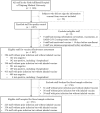Comparing the protection of heterologous booster of inhaled Ad5-nCoV vaccine and hybrid immunity against Omicron BA.5 infection: a cohort study of hospital staff in China
- PMID: 39695978
- PMCID: PMC11654266
- DOI: 10.1186/s12879-024-10250-1
Comparing the protection of heterologous booster of inhaled Ad5-nCoV vaccine and hybrid immunity against Omicron BA.5 infection: a cohort study of hospital staff in China
Abstract
Background: After the exit "zero-COVID" strategy in mainland China by the end of 2022, a large-scale COVID-19 outbreak seeded by Omicron variants occurred. An inhaled adenovirus type-5 vector-based (i.e., inhaled Ad5-nCoV) COVID-19 vaccine was licensed earlier in 2021. In this study, we aimed to assess the real-world effectiveness of a heterologous booster of inhaled Ad5-nCoV vaccine against Omicron infection and compared with the protection from hybrid immunity (i.e., prior breakthrough infection).
Methods: In this retrospective cohort study, we identified 1087 out of a total of 1146 hospital staff from a tertiary hospital in Urumqi city, China from November 22 to December 29, 2022. Demographic characteristics, baseline health status, occupation, behavioral factors, laboratory test of serological IgG antibody, and timeline from immunization to laboratory-testing outcome were obtained. We analysed the individual-level vaccination status of inhaled Ad5-nCoV vaccine, prior SARS-CoV-2 infection status and baseline vaccination status, and other risk factors before follow-up. The protective effects of the heterologous inhaled Ad5-nCoV vaccine and hybrid immunity against Omicron BA.5 infection and hospitalization were calculated as relative rate reduction (RRR), which was estimated using multivariate Poisson regression models.
Results: A total of 1087 hospital staff (median age of 34 years, and 343 males [31.6%]), including 931 accepted for serological antibody tests, were recruited to assess the vaccine effectiveness (VE) of the inhaled Ad5-nCoV booster and hybrid immunity. Among the 1087 participants, 413 had a history of prior SARS-CoV-2 infection (before follow-up) but did not receive an inhaled Ad5-nCoV booster, and 674 reported no prior infection, including 390 who received an inhaled Ad5-nCoV booster. The highest serological IgG antibody level was detected among the inhaled Ad5-nCoV group, with a median of 294.59 S/CO, followed by the hybrid immunity group, with a median of 93.65 S/CO compared to the reference level of the inactivated vaccine group (most of whom received the Sinopharm/BBIBP-CorV vaccine). The inhaled Ad5-nCoV booster and hybrid immunity yielded RRRs of 41.9% (95% CI: 24.8, 55.0) and 97.9% (95% CI: 94.2, 99.2), respectively, against Omicron BA.5 infection, regardless of symptom status.
Conclusion: We found that hybrid immunity could provide a high level of protection against Omicron infection, while a heterologous inhaled Ad5-nCoV booster conferred a moderate level of protection. Our findings supported the rollout of a heterologous vaccination strategy regardless of preexisting vaccine coverage.
Keywords: Inhaled Ad5-nCoV vaccine; SARS-CoV-2; Serological IgG antibody; Vaccine effectiveness.
© 2024. The Author(s).
Conflict of interest statement
Declarations. Ethics approval and consent to participate: This study was approved by the institutional ethics committee of Xinjiang Medical University. Medical records were kept confidential in full at the Sixth Affiliated Hospital of Xinjiang Medical University, and the personal identity of the subjects was not and will not be disclosed in any report on the results of this study. Informed consent is obtained from all the participants. Consent for publication: Not applicable. Competing interests: The authors declare no competing interests.
Figures



Similar articles
-
Safety, tolerability, and immunogenicity of an aerosolised adenovirus type-5 vector-based COVID-19 vaccine (Ad5-nCoV) in adults: preliminary report of an open-label and randomised phase 1 clinical trial.Lancet Infect Dis. 2021 Dec;21(12):1654-1664. doi: 10.1016/S1473-3099(21)00396-0. Epub 2021 Jul 26. Lancet Infect Dis. 2021. PMID: 34324836 Free PMC article. Clinical Trial.
-
Immune responses and transcription landscape of adults with the third dose of homologous and heterologous booster vaccines of COVID-19.Front Immunol. 2024 Sep 12;15:1461419. doi: 10.3389/fimmu.2024.1461419. eCollection 2024. Front Immunol. 2024. PMID: 39328415 Free PMC article.
-
Neutralizing antibody levels associated with injectable and aerosolized Ad5-nCoV boosters and BA.2 infection.BMC Med. 2023 Jul 3;21(1):233. doi: 10.1186/s12916-023-02942-3. BMC Med. 2023. PMID: 37400857 Free PMC article.
-
Safety, immunogenicity, and protective effective of inhaled COVID-19 vaccines: A systematic review and meta-analysis.J Med Virol. 2024 Apr;96(4):e29625. doi: 10.1002/jmv.29625. J Med Virol. 2024. PMID: 38650361
-
A China-developed adenovirus vector-based COVID-19 vaccine: review of the development and application of Ad5-nCov.Expert Rev Vaccines. 2023 Jan-Dec;22(1):704-713. doi: 10.1080/14760584.2023.2242528. Expert Rev Vaccines. 2023. PMID: 37501516 Review.
References
-
- WHO. Classification of Omicron (B.1.1.529): SARS-CoV-2 Variant of Concern. (https://www.who.int/news/item/26-11-2021-classification-of-omicron-(b.1...., October 21, 2022).
-
- WHO. Weekly epidemiological update on COVID-19–19. October 2022. (https://www.who.int/publications/m/item/weekly-epidemiological-update-on..., October 19, 2022).
Publication types
MeSH terms
Substances
Supplementary concepts
Grants and funding
LinkOut - more resources
Full Text Sources
Medical
Miscellaneous

